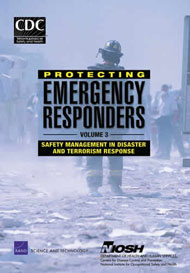Every day across the nation, emergencies occur that threaten our
lives, well-being, property, peace, and security. Every day, we
rely upon our local police officers, firefighters, emergency medical
technicians, public health professionals, and others to arrive quickly
and do what needs to be done to restore the safety, the security,
the peace, and the routine to our lives...
When a disaster, whether natural or manmade, overwhelms the resources
and capabilities of local organizations, responders come in from
other cities, counties, and states-jurisdictions near and far-as
well as from federal agencies, to assist those with local responsibility...
One characteristic of these large, rare, dynamic events is the rapidly
evolving complexity that faces individuals trying to effectively
manage all of the organizations and people, operations and tasks,
equipment and supplies, communications, and the safety and health
of all involved...
This report addresses the protection of emergency responders against
injury, illness, and death on just such rare occasions, when emergencies
become disasters... This report focuses on preparedness (especially
planning and training) and management as means of controlling and
reducing the hazards emergency responders face. It provides a set
of recommendations on how disaster site safety and health management
might be improved...
This report builds on systems and practices currently in use and
was developed primarily for use by local emergency responders, those
individuals and organizations who have been tasked with disaster
site safety and health responsibilities. Additionally, the report
should prove useful to legislators and other federal, state, county,
and municipal officials; trade union officials; industry executives;
safety and health professionals; and researchers who are engaged
in and committed to efforts to make our nation more secure, to respond
effectively and safely to disaster, and to protect a critically
important resource-the community of emergency responders. (from
the Foreword)
The research described in this report was a joint effort of the
Science and Technology Policy Institute (operated by RAND from 1992-November
2003 under Contract ENG-9812731) and the National Institute for
Occupational Safety and Health.
Disclaimer
Mention of any company name or product does not constitute endorsement
by the National Institute for Occupational Safety and Health or
RAND.
This document is in the public domain and may be freely copied
or reprinted.
Copies of this and other NIOSH documents are available from NIOSH.
For information about occupational safety and health topics contact
NIOSH at:
1-800-35-NIOSH (1-800-356-4674)
Fax: 513-533-8573
E-mail: pubstaft@cdc.gov
http://www.cdc.gov/niosh
National Institute for Occupational Safety and Health
Publications Dissemination
4676 Columbia Parkway
Cincinnati, OH 45226-1998
For information about RAND and
its research contact:
RAND Corporation
1700 Main Street, P.O. Box 2138, Santa Monica, CA 90407-2138
1200 South Hayes Street, Arlington, VA 22202-5050
201 North Craig Street, Suite 202, Pittsburgh, PA 15213-1516
310-393-0411
Fax: 310-393-4818
http://www.rand.org/
Cover design by Stephen Bloodsworth
Cover photograph © Mark M. Lawrence/CORBIS
The RAND Corporation is a nonprofit
research organization providing objective analysis and effective
solutions that address the challenges facing the public and private
sectors around the world. RAND’s publications do not necessarily
reflect the opinions of its research clients and sponsors.
RAND® is a registered trademark.
DHHS (NIOSH) Publication No. 2004-144 RAND Publication No. MG-170
|


